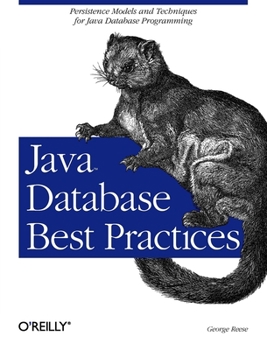Java Database Best Practices
Select Format
Select Condition 
Book Overview
When creating complex Java enterprise applications, do you spend a lot of time thumbing through a myriad of books and other resources searching for what you hope will be the API that's right for the project at hand? Java Database Best Practices rescues you from having to wade through books on each of the various APIs before figuring out which method to use This comprehensive guide introduces each of the dominant APIs (Enterprise JavaBeans,...
Format:Paperback
Language:English
ISBN:0596005229
ISBN13:9780596005221
Release Date:June 2003
Publisher:O'Reilly Media
Length:286 Pages
Weight:0.15 lbs.
Dimensions:0.7" x 7.1" x 9.3"
Customer Reviews
4 ratings
A good choice
Published by Thriftbooks.com User , 21 years ago
I really like reading this book. This book discusses a lot of database concepts. The author talks about how to use the javax.sql libraries. I found the book easy to read. I found the snippets of code useful. I would recommend this book to anyone who wants to learn advanced concepts on databases with JAVA.Michael
A good source of advised best pracitce
Published by Thriftbooks.com User , 21 years ago
I have just seriously reading the chapters about EJB, JDBC, Servlet and JSP, I found that there are some tricks I have used but I have not stated the reason, this book provides some short and brief reasoning for each tips to clarify why I need to do and not to do. It is very handy to me, even I explained that to my associate consultants, I don't need a long conversation. I believe the author does not mean we need to follow the best practice but hope that developers/architect can outline a set of standard/practice for the development. It is the main reason for us to read. If you have your own standard, programmer A has his/her own style, then it is hard to trace and maintain the system.
Good for intermediate Java guy aspiring to be senior
Published by Thriftbooks.com User , 21 years ago
This book hit the sweet spot for me: I had some knowledge of PL/SQL and database concepts already, and would classify myself as an "intermediate" Java developer. I'm almost done with this book, and it has been not only a pleasure to read, but it has really solidified my knowledge of what is important in database design. In a large workgroup setting, there's a tendency to focus on what has been mandated as the database programming API, so I found the author's overview of all major persistence approaches nice, providing some food for thought. I would say the performance tips, which often appear as boxed "Best Practices" throughout the book, are a key good feature of the book. I really like the author's style, which is clear and pragmatic. In the fashion of the famous 80/20 rule, he points out when there are differences in ways of doing things that exist, but don't make *that* much difference. My last observation will sound trivial, but to me it was another thing to like: the book is compact, a little more than half an inch thick, which makes it easy to just take with you whenever there's a bit of predictable downtime (commuting, lunch, etc).
Points you in the right direction
Published by Thriftbooks.com User , 21 years ago
JDO or EJB? JDBC? BMP or CMP? EJB BMP with JDBC and JDO on a RDMS?Have you ever been caught up in the alphabet soup of Java database programming APIs? Have you ever questioned which approach might be best suited for your particular application? Sure you pride yourself on your skills in crafting some pretty mean EJBs, but is that the best path to head down with your latest project? O'Reilly's new book "Java Database Best Practices" attempts to answer these questions and more.For such a relatively thin book (267pp), it touches on a wealth of topics vital to the subject at hand. Reese lends his insights concerning database architectures, database design, transaction management, and persistence methods using JDBC, EJB, and JDO. While this isn't intended to be an introductory tome, you are also not expected to be proficient with all these APIs. As such, the latter third of the book contains tutorials on relevant J2EE APIs, JDBC, JDO, and SQL.Reese does not exhaustively go into detail on every topic, each of which could probably warrant its own book. Rather he arms us with just enough information to make informed decisions about which method might best serve our applications. Aside from merely determining which set of APIs might be best suited in a given situation, Reese also points out several "best practices" to help guide us in design and implementation (for example, "use join tables to model many-to-many relationships").I do have a couple of small complaints about the book. For one, "best practices" are highlighted throughout the text, but they are not enumerated or indexed in any manner. An enumerated list of these "best practices" would be welcome. Secondly, MVC purists will likely cringe at the JSP examples. While the architecture shown (JSPs as view and control, database access through taglibs) may be valid for small web applications, I don't feel it should be highlighted as a "best practice", particularly for enterprise applications. None of these complaints are major however, and do not overly detract from the value of the book."Java Database Best Practices" accomplishes what it sets out to do. This is a book that might be handy to have to pass around your development team in the design phase to get you all on the same page when making some critical choices. This book could also well serve those, such as managers perhaps, seeking a broad survey of Java database programming. I also feel that this book would make an excellent companion text for a college database programming course using Java. While "Java Database Best Practices" won't make you an expert with all of these APIs, it will certainly point you in the right direction.





